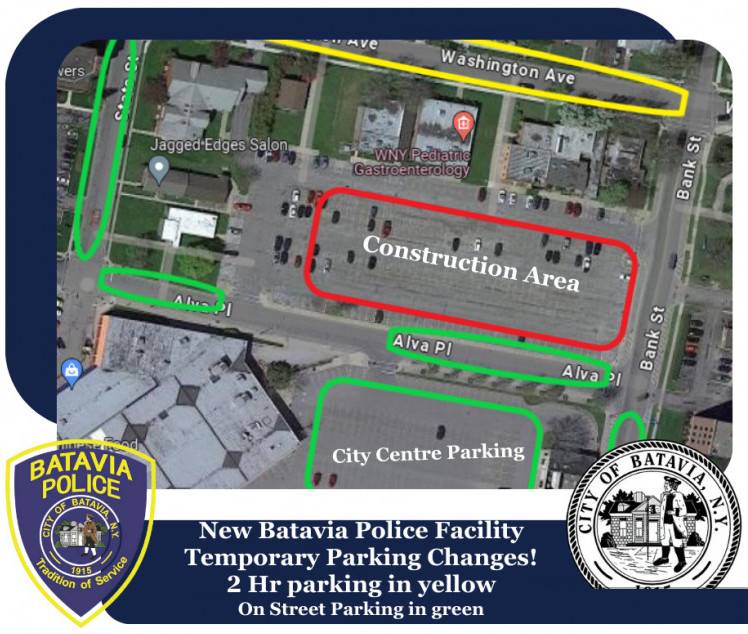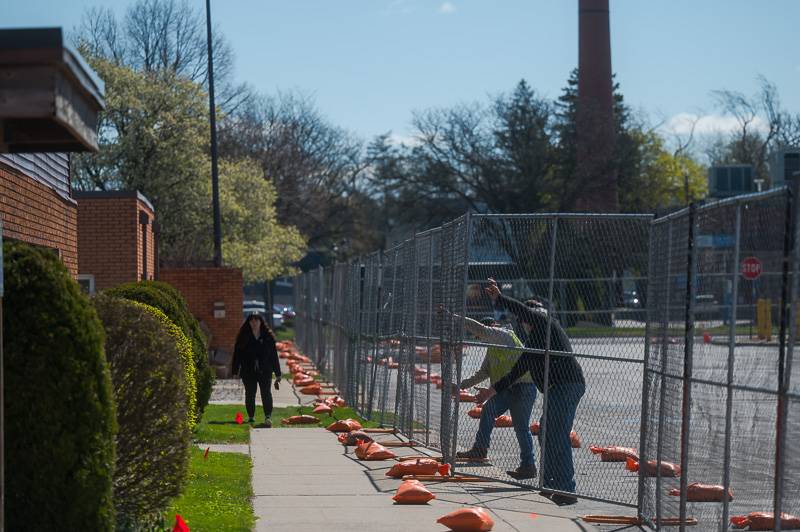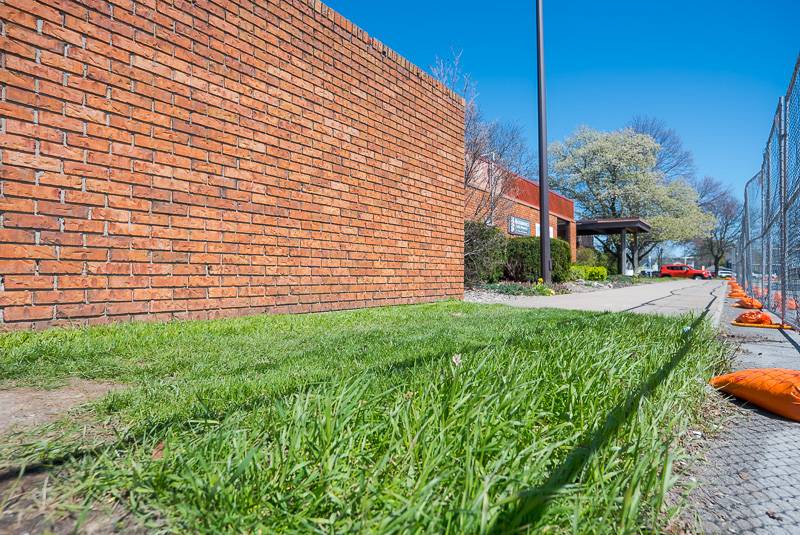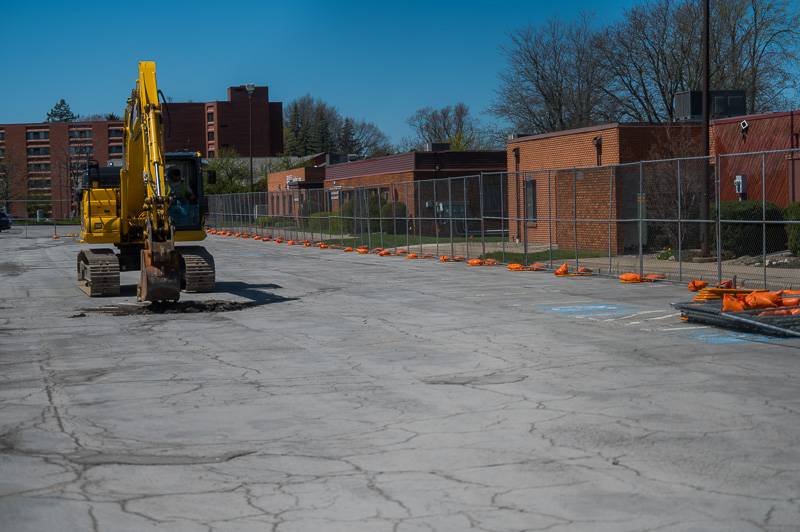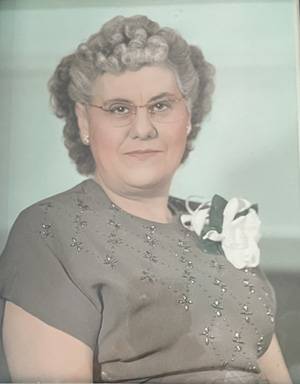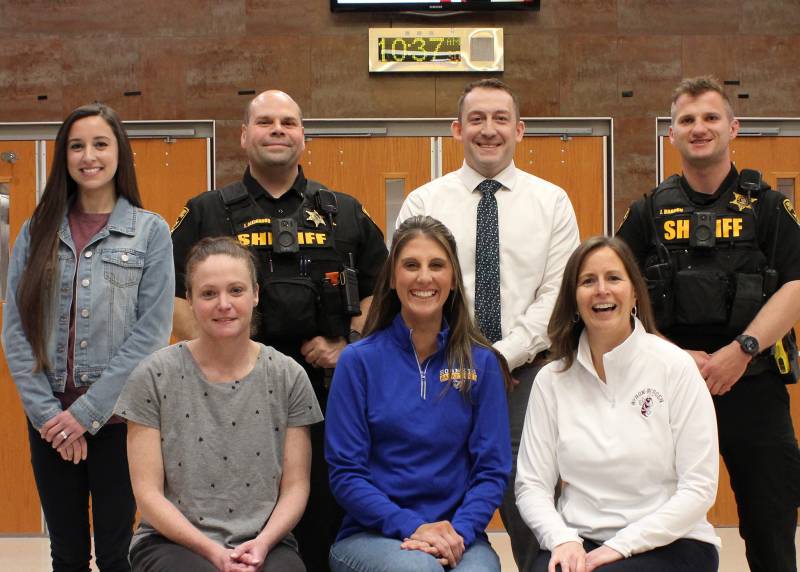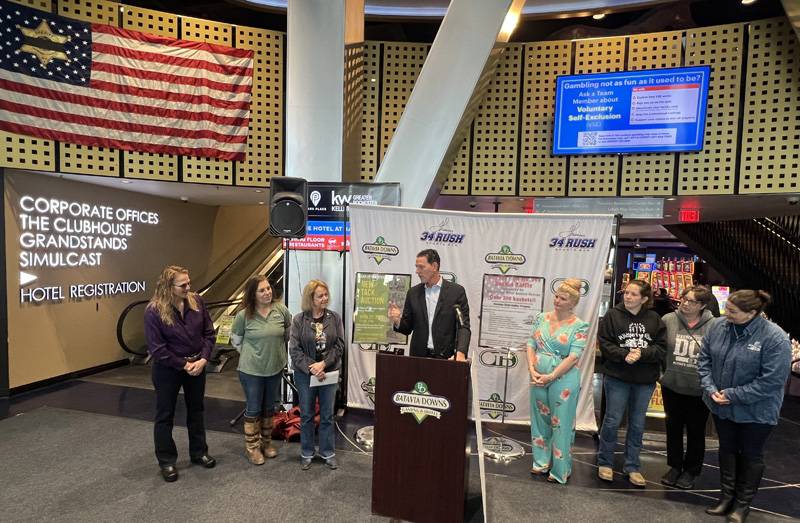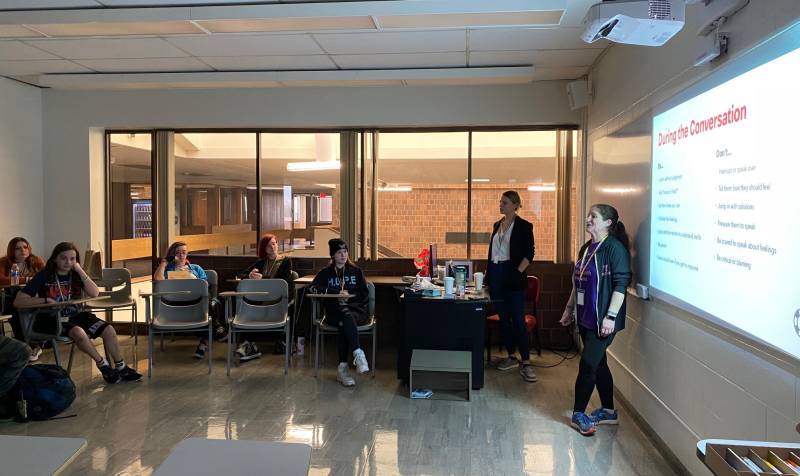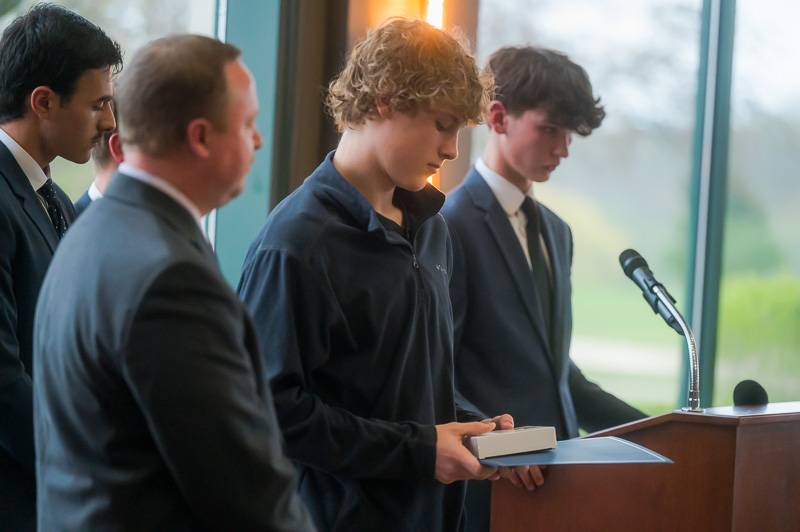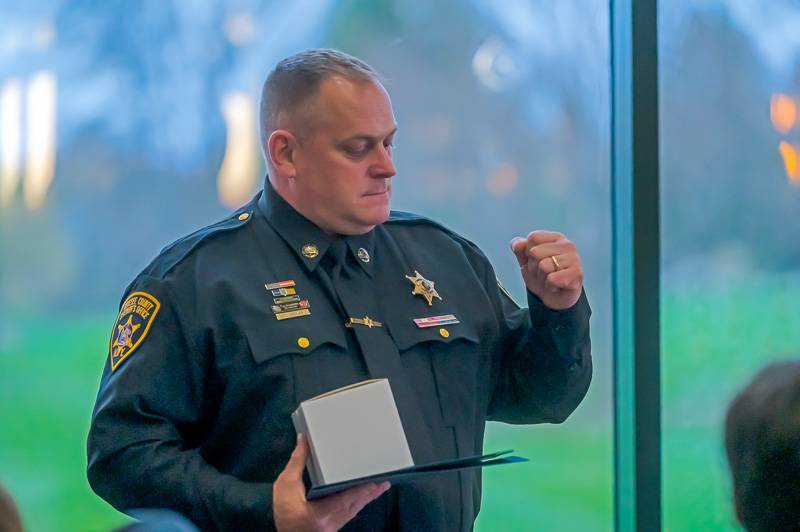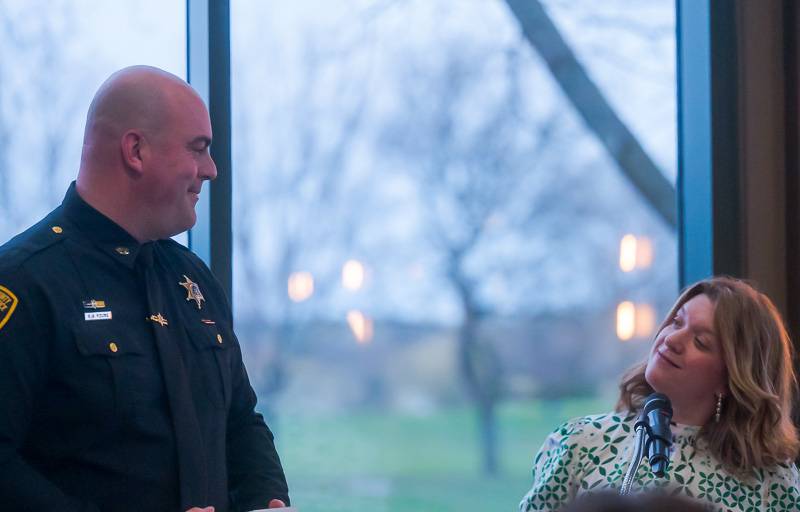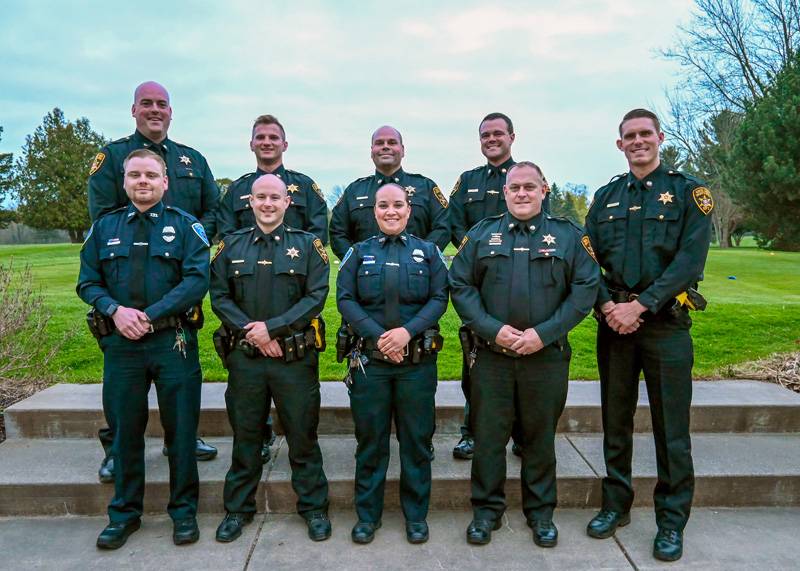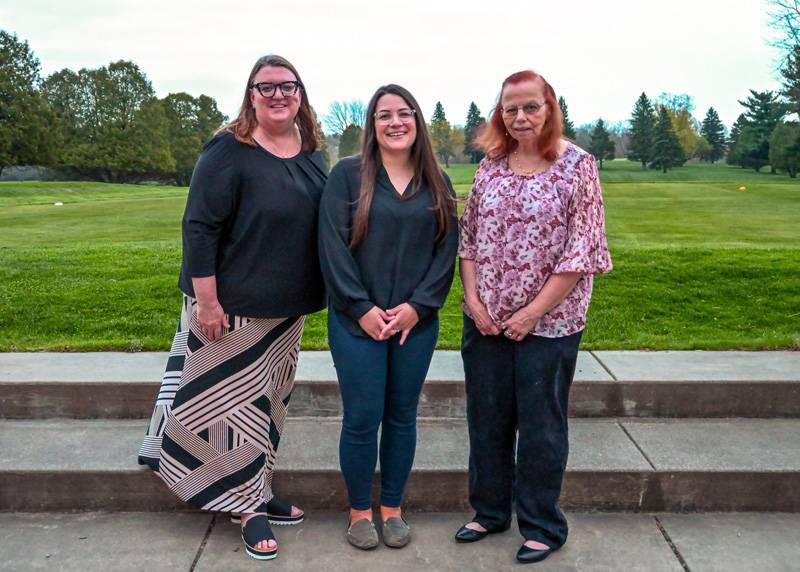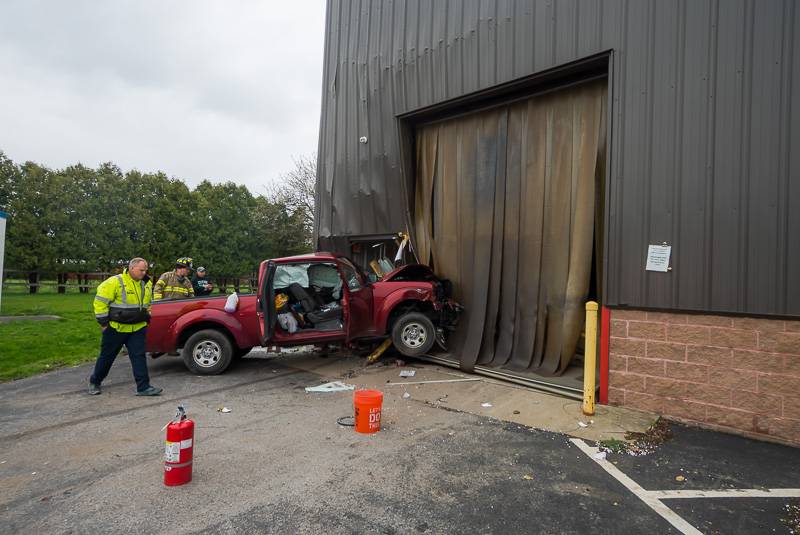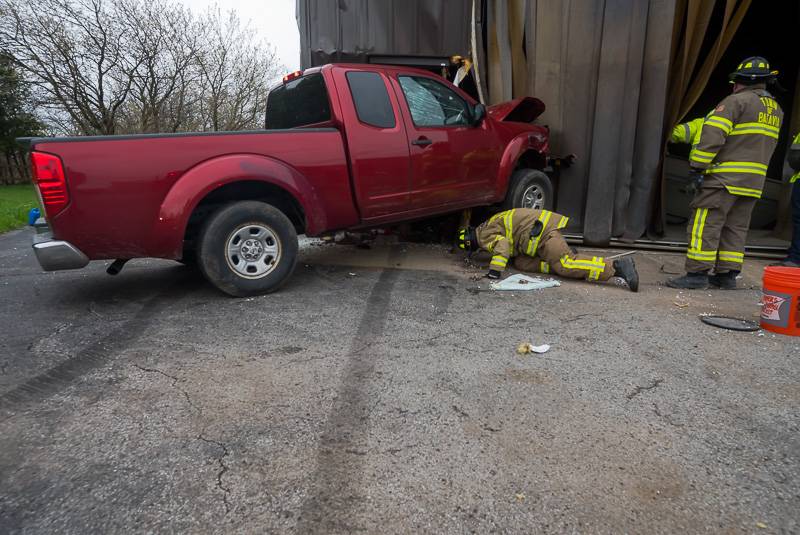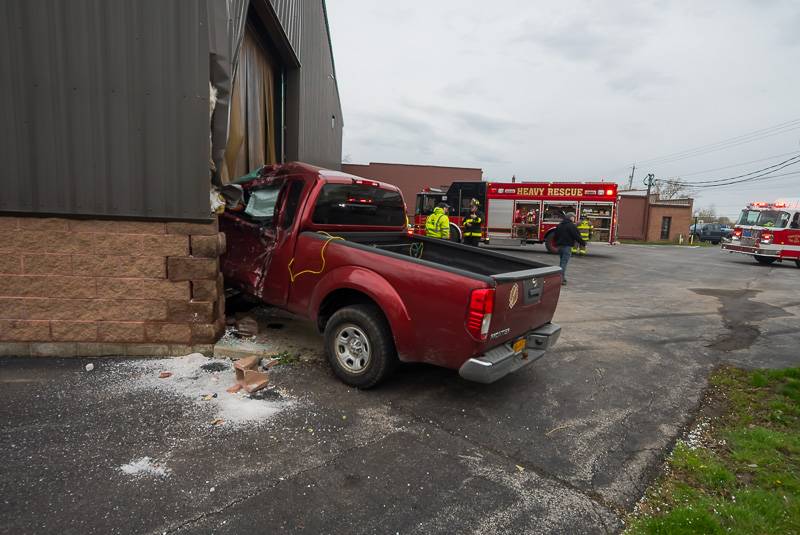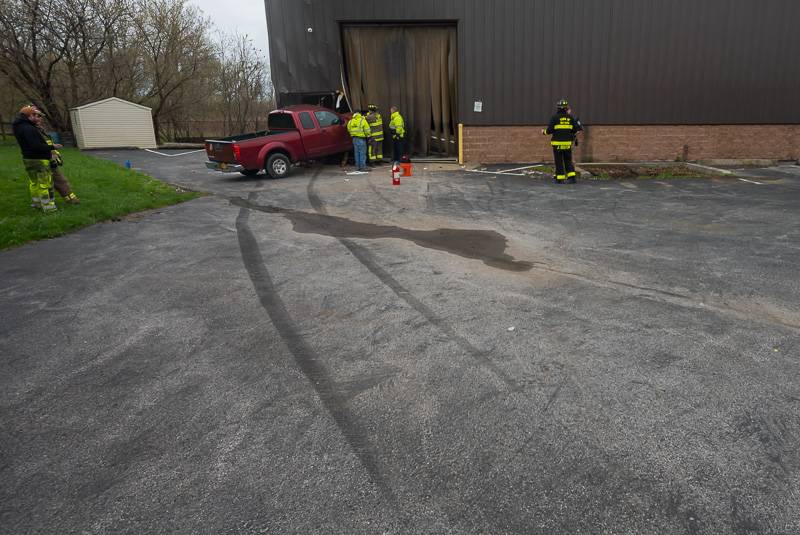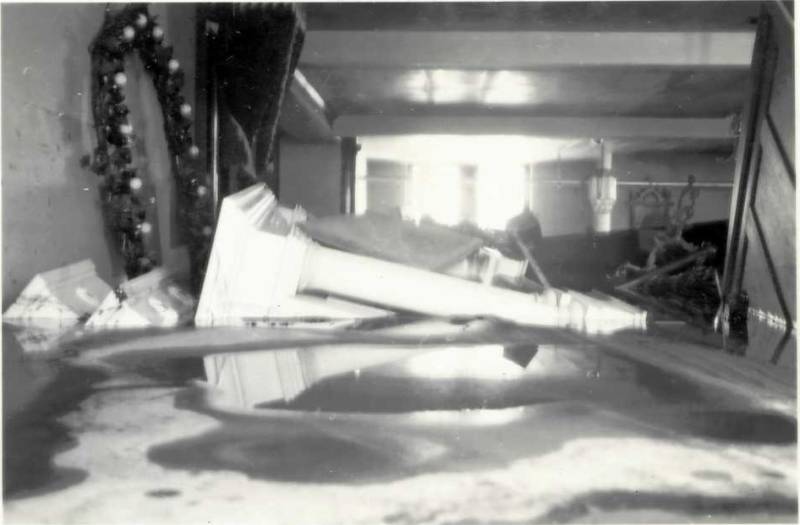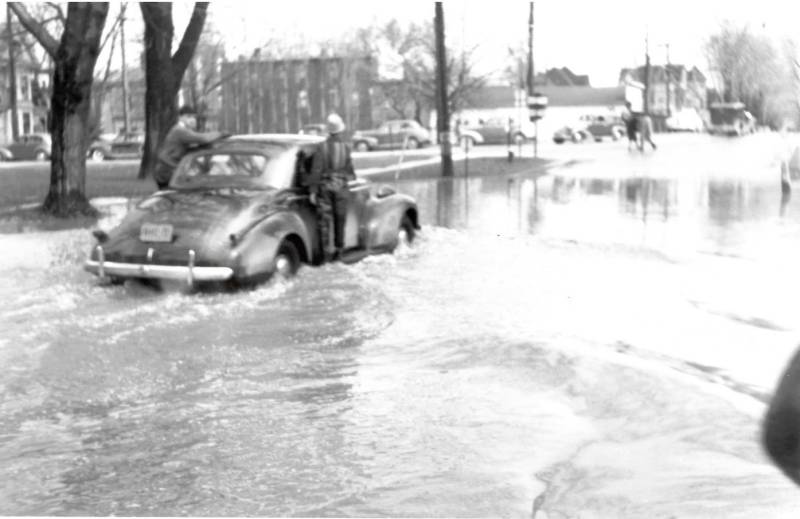Downtown business owners battle for their patients, city considers options
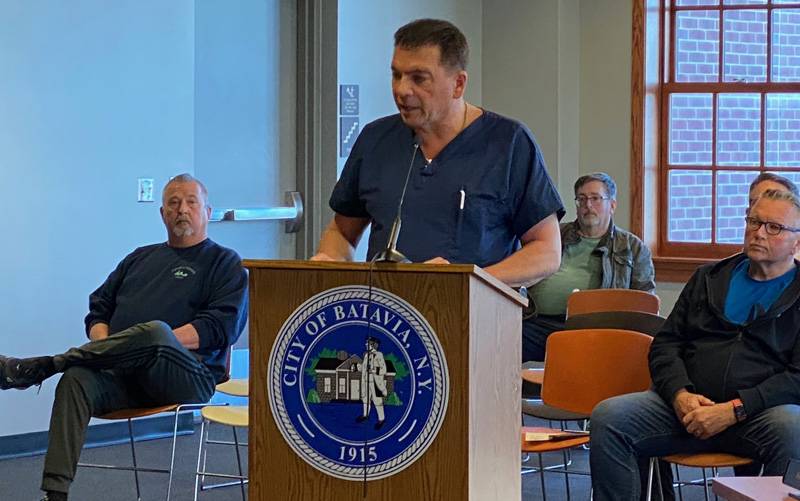
Photo by Joanne Beck
A private meeting that began at the city police station Monday for a dozen downtown business owners to discuss parking concerns with city management and the architect of a new police station spilled out before City Council later during an open conference session at City Hall.
The meeting lasted for more than an hour, and when walking out of police headquarters at 10 W. West Main St., Patrick Privatera, owner of Village Physical Therapy, seemed none too optimistic about the future of the business that he established in the corner of Alva Place and State Street, adjacent to a parking lot that is being completely devoured by construction staging for the new police facility.
“So we deal with patients who have mobility issues that have cardio, cardiac, you know, less than lower cardiovascular stamina, they can't walk from across the street. I mean, it's easy to say go park by a JCPenney, but if you're someone with COPD or can't walk 50 feet, that's going to make the difference between coming to our office and not coming to our office. They're not going to come to our office.”
That’s not how he understood it would be when city management spoke to business owners in January 2022. Manager Rachael Tabelski had introduced the idea that “we’re going to be neighbors and build a police station” without any discussion, he said.
“There wasn’t really any asking what does your business need? It was just saying this is happening,” he said. “And, in fact, I’m surprised it took this long, because, I mean, I put together a pretty lengthy document of some concerned questions and concerns, I asked for a meeting, we were supposed to have met. And she was funny. It was an email exchange; she basically called me instead in lieu of a meeting and accused me of being anti-police, and nothing’s further from the truth. I just invested a quarter of a million dollars in this building and relocated my practice there. I just want some place for my patients and my staff to park, that’s it.”
He said that parking for this week has been ok, but he’s been told the entire parking lot will be closed for construction. He’d like the city to give business owners more time to figure out how to deal with this, but “they’ve got weather, they’ve committed a lot of resources to this, whether it happens or not, they need to do something,” he said.
“I hope they give us time. I have room potentially on my property there to construct our own parking,” he said. “If I had more time, I might be able to, but not in four days.”
As others headed to City Hall for the council meeting, Privatera opted not to go. He said emotions were heated, and he didn’t think the situation would get resolved in that meeting.
Dr. Tom Mazurkiewicz came out of police headquarters more frustrated than satisfied.
His take: The city isn’t willing to negotiate a reduction in the construction area's footprint and a move of the staging area to the other side of Alva Place.
Mazurkiewicz, who has a chiropractic practice on Washington Avenue, said the only response officials gave business owners to the reason for not putting the staging area next to JCPenney was, “It’s not in our budget.”
See also: Police station project manager explains need for space around construction site
He and fellow business owner Joseph Canzoneri said that their businesses will survive the 18 months of disrupted parking even though revenue will drop significantly, but that isn’t really their number one concern, said Mazurkiewicz.
“It’s a safety issue,” he said. “That’s all I care about.”
Doctors Joseph Canzoneri, Adam Gregor and property owner Sharon Kubinec picked up the ball and ran with it during the conference meeting. Canzoneri, a longtime podiatrist also on the west side of the parking lot along State Street, spoke about the plight of his patients and the hurdles they have to overcome as it is without having to deal with parking issues.
“Many of these people suffer from COPD and carry oxygen, have cardiac issues, neuromuscular and severe back problems from trauma broke, degenerative changes, affecting balance and ability to walk any distance or on uneven surfaces, ” he said. “They have diabetic foot issues, such as ulcerations or amputations, have a leg prosthesis, individuals post-surgical both from podiatry and orthopedics (Le Roy physical therapy is affected). Patrons with poor vision are forced to walk long distances or on uneven terrain, not to mention young parents carrying children in car seats and using strollers. Many patients use assisted devices like wheelchairs, motorized scooters, crutches, canes, open cast boots and braces, making it even more difficult in the winter to traverse these distances and different terrains, curbs, grass, stone, and the list goes on.”
The issue for him and the other business owners is that their patients, although being offered parking on side streets, are parallel parking and not very close to the medical office. Parallel parking is not the same as handicapped parking, Canzoneri said, because there are still obstacles to getting out of one’s vehicle and navigating uneven terrain from the vehicle to the office.
Why are people so up in arms now, after the city has had planning sessions and press releases about construction and timelines for this new facility?
“We understand the city had public meetings regarding the approval of the police department. We understand the proposed building will be on designated city property, and the site and rendering of the building were made public,” Canzoneri said. “What we did not know is the staging footprint until nine days ago. There should be an opportunity for public input in a public hearing, especially when the proposal adversely affects the business detrimentally. We are all within 500 feet distance to the project. At a minimum, notices should have been sent out for public input prior to this project going out for bid. When was the planning board meeting set regarding the staging area? If the city bypassed this due diligence required for all projects believing that the city doesn’t need input because it is the approving and permitting authority, then that is poor communication, poor community outreach and poor planning.”
Gregor, who took over the dental practice formerly occupied by Dr. Kubinec at 180 Washington Ave. about two years ago, said that he was “deeply troubled by the negative impact this closure will have on my patients in my practice.” As in Canzoneri’s case, Gregor’s patients also have mobility issues or young children in tow, he said, and the parking lot closure will “undoubtedly create an inconvenience” at best.
“I have not once been approached regarding how this project could impact the care of my patients and on my business. My displeasure with this project arises from the fact that it is already different from the proposed plan, which Dr. Joe had just mentioned was only presented to us last week. We collectively as business owners had concerns about the construction zone footprint as it was originally presented to us. We were assured that measures would be taken to minimize disruption to the businesses operating within the complex,” he said. “However, the sudden and expanded closure of the parking lot has blindsided us and proposed this year poses a serious threat to my patients and to the well-being of my practice. The closure of the parking lot threatens to undermine all the hard work and investment I've put into building my practice in this location. The closure of the parking lot will undoubtedly create inconvenience and frustration for my patients, potentially leading them to seek dental services elsewhere.
“Furthermore, the lack of parking will likely turn new patients from choosing my practice and may even cause some of my existing patients to leave. Dental Care is already a daunting task for many individuals and adding the stress of finding parking only serves to exasperate their anxiety,” he said. “I believe that there are ways to mitigate the disruption without jeopardizing the livelihoods of those who operate here. To not care about the situation is to not care about us as medical professionals, business owners and taxpayers just as important to not care about the situation as to not care about the citizens who seek care in our offices. I hope that moving forward, we can collaborate and cooperate with each other rather than contend with one another.”
Sharon Kubinec, who served as practice manager for her husband during his time as dentist at the site, spoke as a concerned property owner and someone who knows how busy those medical practices are each day, she said. She also cited Ricky Palermo as a patient who uses at least three of the services in that complex and who will have potential difficulties navigating the path to each office in his wheelchair. Palermo was invited to tour the parking lot and surrounding areas since there wasn’t wheelchair access to the second-floor meeting room at the police station, but could not make that meeting.
“Ricky Palermo, who wanted to be here tonight, goes to Dr. Joe, Dr. Adam and Dr. Tom, and he can't go to his foot doctor, his chiropractor and his dentist for 18 months the way it is situated now over there,” she said.
She suggested that the city could do something similar to what United Memorial Medical Center had done some years ago with a bus that shuttled employees between the North Street site and Jerome Center on Bank Street when parking was tight. Only this time, the bus would pick up patients at the former JC Penney building and take them to the medical offices, she said.
Canzoneri proposed a larger parking area for patients and clients, and city and contractor staff would park in the lot across Alva Place closer to the JC Penney site, which he said would also be used as more of a staging area.
“This will still provide a convenient staging area, plenty of room to stage safely, also cost-effective, and most importantly, safety for our clients and pertness, not to mention relief to the detrimental financial risks to the businesses that are being imposed by these egregious parking restrictions and proposals,” he said.
There are more than medical practices at the complex, such as Amanda Lowe’s business. Lowe, the owner of Jagged Edges, said outside police headquarters after the earlier meeting that she hated to say anything publicly because she understands her business is sustaining far less impact than some other businesses. However, if she knew this parking restriction was coming, she might have selected a different location when it was time to relocate from her original site on Veterans Memorial Drive.
“I definitely bought the location based on knowing that I had the parking,” Lowe said. “ I wasn't aware of how big the project is. And you know, the impact it was going to have on our customers coming in. It probably would have made a difference on the location because there were two different locations I was looking at. Parking was one of the biggest reasons (she selected her current location). I knew that this was in the works before, but coming from being in the town to come into the city, I wasn't really fully aware of how long the construction would be and the impact and all the businesses.”
Marc Johnson, owner of Millennium Computers, may not experience the same impact as the medical offices, but it isn’t negligible either.
“I’ve got people coming in with heavy computers in their hands. They're not going to walk from JC Penney's over to my place,” Johnson said.
He is considering converting some of the green space he owns next to his office into parking for his business.
“I haven’t done anything with it for 20 years except mow it,” he said. “If push comes to shove, I'll just put my own parking in. Ideally, it'd be nice to share the burden with the city or whoever else and make it bigger than just a handful of parking spots for Millennium. And then, you know, my neighbors that are in the medical world can have some handicapped parking there.”
City Manager Rachael Tabelski said that she believed the information she initially provided was correct regarding construction coexisting with parking near business offices.
“Once we learned that the contractors controlled the entire site, we had to decide whether to delay the project, spend more money on it, or just take the entire parking lot and find more accommodations for the business owner.”
She said those accommodations under immediate consideration are adding wheelchair ramps for easier access to curbside parking. There are a potential 68 parking spaces on the streets around the complex. The city is also considering hiring a shuttle to assist patients from parking to offices.
“If people parked at City Centre, they could get a ride in, Tabelski said. “Hopefully, that would take care of issues with folks with mobility.”
While there were public hearings about the project where anybody could have raised parking issues, it was never mentioned.
“We went through the process, and in everyone's mind, you saw a rendering that still had the big L going through it where parking is,” Tabelski said. “We all should have jumped to the conclusion, ‘Oh, that's great at the end, but what happens during construction,’ right? I definitely lean on the architects we work with and the contractors to guide me through this because I'm neither. I'm a city manager. But I do want to make sure that our businesses have what they need to get their patients in, and I go to a lot of the businesses, so it's definitely not personal; we want to help. We don't want to hurt their business in any way.”
She said the city is “all over” a proposal by Marc Johnson, owner of Millennium Computer on Washington Avenue, to convert a green space he owns next to his building into a parking lot.
“It'll be a temporary construction, an accommodation,” Tabelski said. “We will be (working on it) as soon as we can get millings and build a foundation out there. He has offered -- as far as I know -- I'd hate to speak for Marc -- to allow some public parking there as long as he reserved spots for his business. So, we're interested. He came with this great solution and I think we can get eight to 10 spots there. There's also another grass parcel. I'm not sure who owns it, but I'm going to try to find out and see if they'd be interested in a similar thing.”
Council President Eugene Jankowski Jr. said he understands that it's going to be an inconvenience for people.
“But it's been an inconvenience for men and women in the police department to work in an antiquated building and not be able to serve the public. That building is not just a building; it's a tool because there's certain requirements for juveniles, for victims, for defendants. They have rights. They have laws that protect them and we are not able to comply with that as efficiently get in the building, not to mention that the gentleman we all know, wasn't even able to get into the building for a meeting,” Jankowski said, referring to Palermo. “It’s not easy to get a sense of where the new building will be. So when I hear we're supporting the police, and then I see that it doesn't appear that we're supporting the police. I know as a former police officer, how I would be feeling right now when I hear all this outreach and all this stuff going on. And I see the city making every attempt to try to make accommodations. But it's not making anybody happy. So we’ve got to reach a middle ground, we’ve gotta reach some kind of compromise, we have to get this building over the finish line. Because if we don't, it was explained just a few minutes ago, extreme cost overruns will put the project in jeopardy.”
After the meeting, he said that he was very disappointed in the city's response when “we’re trying to do something good for the community and our public safety, which is very valuable to this community.”
“I really take public safety very seriously. And yet, we're meeting all this resistance over a few parking spaces that we're trying to make accommodations for. But that doesn't seem to be good enough,” he said. “This is all temporary. This is only for a few months, and we're doing our best to try to work it out in the meantime. And there are many ideas, and I'm sure the city manager will find a solution that will do her best to accommodate as many ideas as we can any way we can.”
When asked what he thought about Jankowski’s public response to business owner comments and an appeal for consideration, Canzoneri said he felt “terrible.”
“They show no empathy for the patients,” he said.
Howard Owens contributed to this story.
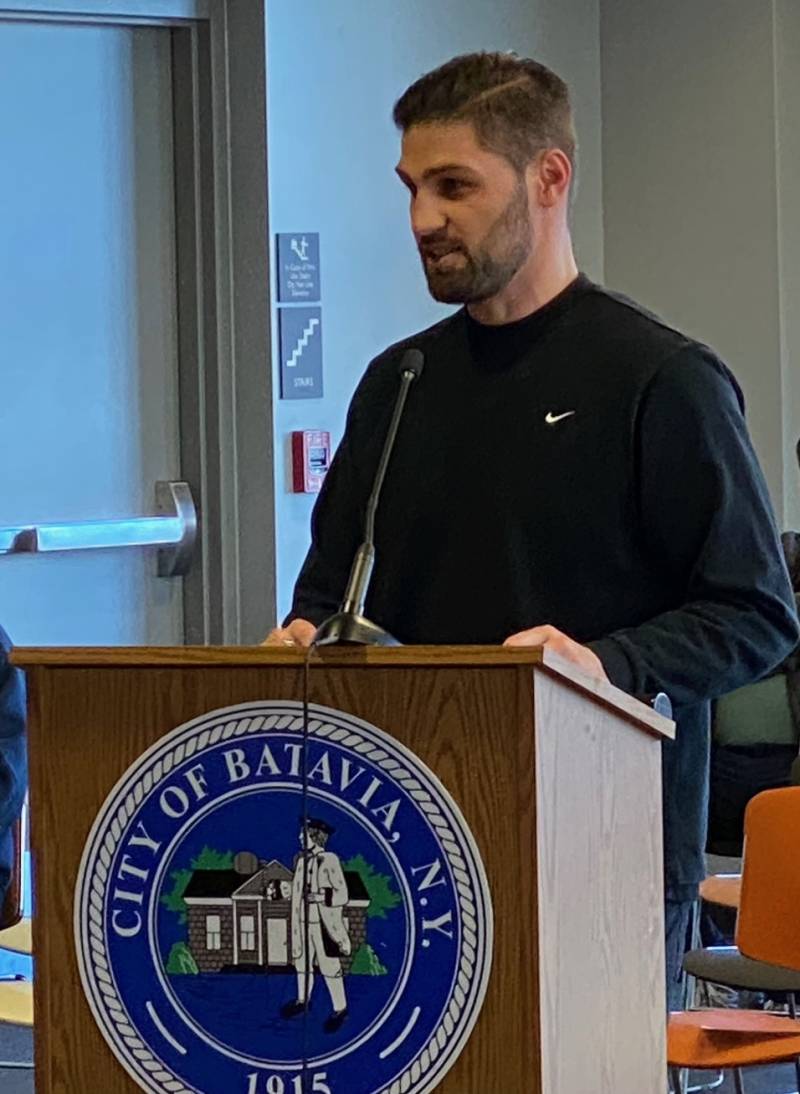
Photo by Joanne Beck

